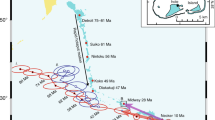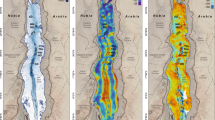Abstract
Vine and Wilson1, using the Vine and Matthews2 hypothesis, were the first to try to relate the magnetic pattern over the crests of the mid-ocean ridges to the known geomagnetic time scale to determine the spreading rate over the past few million years. Many determinations of spreading rate at the axis of the ridge during Plio-Pleistocene times have been published: Le Pichon3 and Morgan4, for example, used spreading rates computed for the axial magnetic pattern (10 Myr: anomaly 5 of Heirtzler et al.5 or for the past 5 Myr respectively) even when trying to assess the properties of instantaneous plate kinematics. Likewise in the systematic inversion of Minster et al.6 anomalies 3 and 5 were generally used thus averaging plate speeds over the past 5–10 Myr. Minster and Jordan7 sought to improve this and redetermined the spreading rates using magnetic anomalies 2 and 2′ yielding a mean averaging interval of <3 Myr. Here we examine plate behaviour over a shorter time scale in the reasonably well-surveyed axial region of the Mid-Atlantic Ridge south of the Azores. The average opening rates we obtained for this region for magnetic anomalies 1 (Brunhes), 2 and 2′ using two different geomagnetic time scales indicate that (1) there was a relative slowing down of the opening between anomalies 1 and 2 which may be of global significance; (2) the opening is compatible with a rigid plate model when it is averaged over ∼2.5 Myr although for shorter averaging times (1.8 and 0.7 Myr) there is some evidence of non-rigidity of the plates. Thus different segments of the Mid-Atlantic Ridge may display an independent behaviour and, with respect to relatively short time intervals, may show departures from characteristics typically associated with slow accretion.
This is a preview of subscription content, access via your institution
Access options
Subscribe to this journal
Receive 51 print issues and online access
$199.00 per year
only $3.90 per issue
Buy this article
- Purchase on Springer Link
- Instant access to full article PDF
Prices may be subject to local taxes which are calculated during checkout
Similar content being viewed by others
References
Vine, F. J. & Wilson, J. T. Science 150, 485–489 (1965).
Vine, F. J. & Matthews, D. H. Nature 199, 947–949 (1963).
Le Pichon, X. J. geophys. Res. 73, 3661–3697 (1968).
Morgan, W. J. J. geophys. Res. 73, 1959–1982 (1968).
Heirtzler, J. R., Dickson, G. O., Pitman, W. C. III, Herron, E. & Le Pichon, X. J. geophys. Res. 73, 2119–2136 (1968).
Minster, J. B., Jordan, T. H., Molnar, P. & Haines, E. Geophys. J. R. astr. Soc. 36, 541–576 (1974).
Minster, J. B. & Jordan, T. H. J. geophys. Res. 83, 5331–5354 (1978).
Glenn, M. F. Int. Hydrog. Rev. 67, 35–39 (1970).
Renard, V. & Allenou, J. P. Int. Hydrog. Rev. 56, 35–67 (1979).
Anderson, R. N., McKenzie, D. P. & Sclater, J. G. Earth. planet. Sci. Lett. 18, 391–407 (1973).
Le Douaran, S. & Francheteau, J. Earth. planet. Sci. Lett. 54, 29–47 (1981).
Talwani, M., Windisch, C. C. & Langseth, M. G. J. geophys. Res. 76, 473–517 (1971).
Bernard, P., Cuer, M., Bayer, R. & Francheteau, J. (in preparation).
Greenewalt, D. & Taylor, P. T. J. geophys. Res. 79, 4401–4405 (1974).
Needham, H. D. & Francheteau, J. Earth. planet. Sci. Lett. 22, 29–43 (1974).
Renard, V. Bull. Soc. Geol. Fr. 18, 801–805 (1976).
MacDonald, K. C. Bull. geol. Soc. Am. 88, 541–555 (1977).
Mankinen, E. A. & Dalrymple, G. B. J. geophys. Res. 84, 615–626 (1979).
Rea, D. K. & Scheidegger, K. F. J. Volcan. geotherm. Res. 5, 135–148 (1979).
Arcyana Science 190, 108–116 (1975).
Ballard, R. D. et al. Science 190, 103–107 (1975).
Ballard, R. D., Francheteau, J., Juteau, T., Rangin, C. & Normark, W. Earth. planet. Sci. Lett. 55, 1–10 (1981).
Storzer, D. & Selo, M. Bull. Soc. Geol. Fr. 18, 807–810 (1976).
Selo, M. & Storzer, D. C. r. hébd Seanc. Acad. Sci., Paris D289, 1125–1127 (1979).
MacDonald, K. C., Becker, K., Spiess, F. N. & Ballard, R. D. Earth planet. Sci. Lett. 48, 1–7 (1980).
Iaga Division 1 Study Group J. geophys. Res. 81, 5163–5164 (1976).
Bird, P. & Phillips, J. D. J. geophys. Res. 80, 4021–4027 (1975).
Author information
Authors and Affiliations
Rights and permissions
About this article
Cite this article
Douaran, S., Needham, H. & Francheteau, J. Pattern of opening rates along the axis of the Mid-Atlantic Ridge. Nature 300, 254–257 (1982). https://doi.org/10.1038/300254a0
Received:
Accepted:
Issue Date:
DOI: https://doi.org/10.1038/300254a0
This article is cited by
-
Second-order ridge axis discontinuities in the south Atlantic: Morphology, structure, and evolution
Marine Geophysical Researches (1991)
-
Spreading rates, rift propagation, and fracture zone offset histories during the past 5 my on the Mid-Atlantic Ridge; 25°–27°30′ S and 31°–34°30′ S
Marine Geophysical Researches (1991)
-
La région axiale de la dorsale sud-ouest indienne entre 53° est et 59° est: Son evolution depuis 10 Ma
Marine Geophysical Researches (1988)
-
The geology of the Oceanographer Transform: The transform domain
Marine Geophysical Researches (1985)
Comments
By submitting a comment you agree to abide by our Terms and Community Guidelines. If you find something abusive or that does not comply with our terms or guidelines please flag it as inappropriate.



